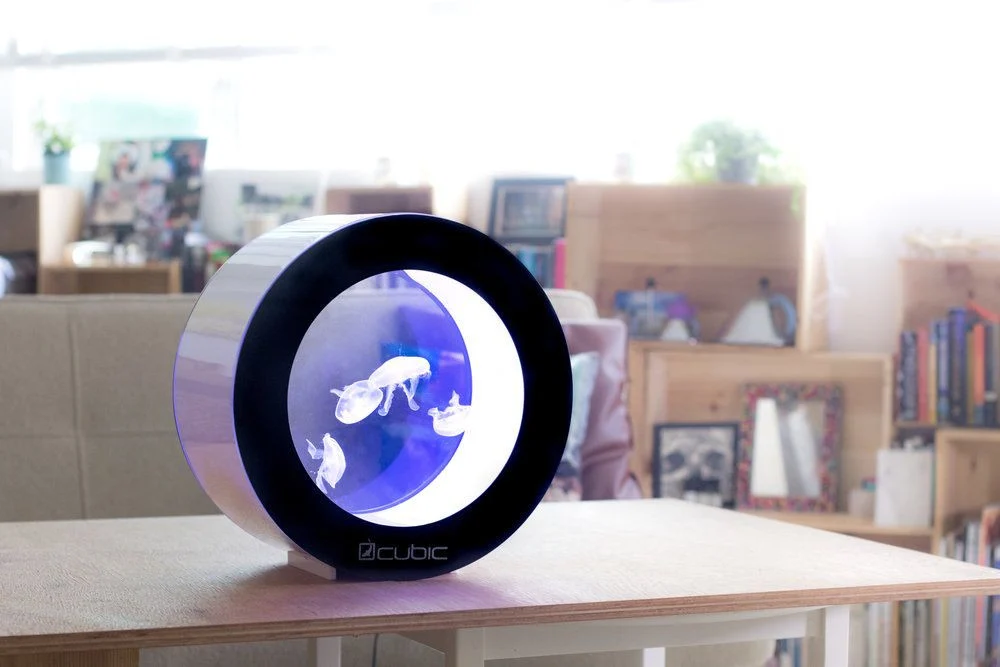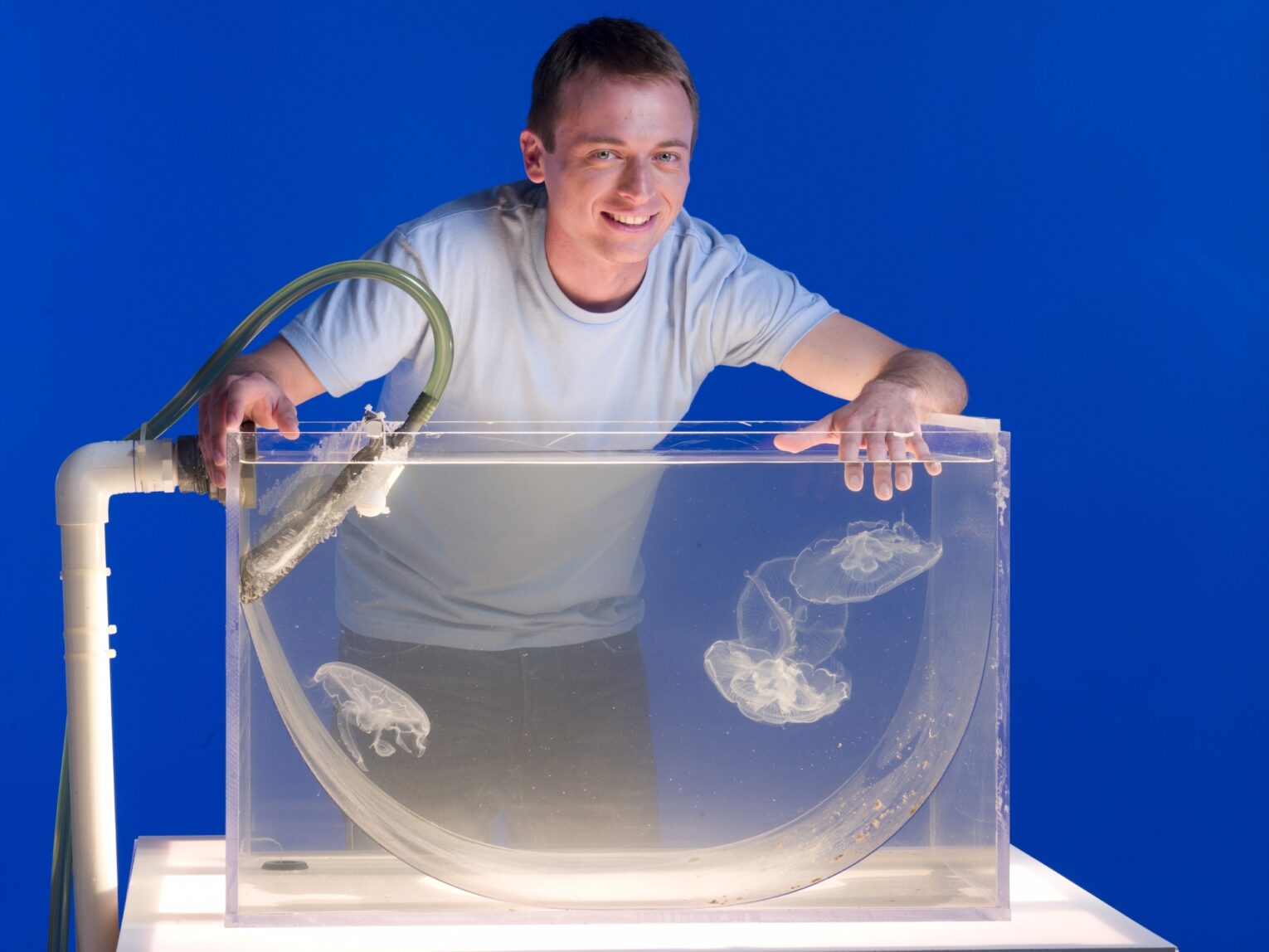Jellyfish, with their tranquil and hypnotic movements, have become increasingly popular in the world of aquarium enthusiasts. However, maintaining a jellyfish tank is a unique endeavor, distinct from traditional fish aquariums. It involves a specialized approach to ensure these delicate creatures thrive. A jellyfish tank not only adds a touch of serene beauty to any space but also offers an intriguing insight into the care of these fascinating marine animals.
The health and well-being of jellyfish are directly tied to the environment in which they live. Unlike more common aquarium inhabitants, jellyfish are particularly sensitive to changes in water quality, temperature, and tank conditions. Proper maintenance is crucial to avoid stress and potential harm, ensuring that these delicate creatures can float gracefully and remain healthy in their aquatic home.
An Overview of What the Guide Will Cover
This guide is designed to walk you through the essentials of jellyfish tank maintenance. Covering a range of topics, it will provide insights into:
- Setting Up the Right Environment: Understanding the specific needs of a jellyfish habitat, from tank selection to the setup.
- Water Quality Management: Guidelines on maintaining optimal water conditions, including salinity, pH, and cleanliness.
- Equipment Maintenance: How to care for and maintain the specialized equipment required for a jellyfish tank.
- Feeding and Health Care: Tips on the proper nutrition for different types of jellyfish and how to monitor their health.
- Common Challenges and Solutions: Identifying and resolving typical issues that may arise in jellyfish care.
By the end of this guide, you’ll be equipped with the knowledge needed to not only maintain a jellyfish tank but to ensure your jellyfish thrive in their carefully crafted environment. Whether you’re a seasoned aquarist or new to the world of jellyfish, this guide aims to enhance your understanding and skills in the rewarding practice of jellyfish keeping.

Tank Setup and Water Quality for Jellyfish
A. Significance of a Well-Established Tank Setup
A proper tank setup is crucial for the health and well-being of jellyfish. Jellyfish are delicate creatures that require a specific type of aquarium to thrive:
Kreisel Tanks: Most jellyfish need a kreisel tank, a special type of aquarium that creates a gentle, circular flow of water. This mimics the open ocean’s environment, allowing jellyfish to float freely without getting stuck against surfaces.
Size and Design: The tank size should accommodate the number and size of jellyfish. Avoid sharp edges or decorations that could harm the jellyfish. The tank’s design should also facilitate easy cleaning and maintenance.
Filtration System: A high-quality filtration system is essential to remove waste products and keep the water clean. The system should be tailored to avoid strong currents or suction that could damage the jellyfish.
B. Importance of Water Quality and Temperature Control
Maintaining the right water quality and temperature is vital for jellyfish:
Water Quality: Jellyfish are sensitive to changes in water quality. The water must be kept free of toxins and pollutants. Regular testing for ammonia, nitrites, nitrates, pH, and salinity is important to ensure the water remains within safe parameters.
Temperature Control: Different species of jellyfish require different temperature ranges. Consistent temperature is key, as fluctuations can stress or harm the jellyfish. Using a reliable aquarium heater and regularly monitoring the water temperature is crucial.
C. Tips for Maintaining Stable Water Parameters
Regular Water Testing and Changes: Test the water parameters regularly using aquarium test kits. Perform partial water changes weekly or as needed to maintain water quality.
Proper Filtration: Ensure your filtration system is appropriate for a jellyfish tank. Clean and maintain the filters regularly to keep them functioning efficiently.
Temperature Monitoring: Use a reliable aquarium thermometer and check the temperature daily. Adjust the heater settings as necessary to maintain a stable environment.
Avoid Overfeeding: Overfeeding can lead to poor water quality. Feed your jellyfish the recommended amount and remove any uneaten food promptly.
Use of Water Conditioners: Use water conditioners to remove chloramines, chlorine, and heavy metals from tap water before adding it to the tank.
Acclimatization: When introducing new jellyfish or after a water change, acclimatize the jellyfish slowly to prevent shock from sudden changes in water conditions.
A well-established tank setup and rigorous maintenance of water quality and temperature are fundamental for the health of jellyfish in an aquarium. Regular monitoring and maintenance routines are key to providing a safe and healthy environment for these delicate and fascinating creatures.
Dietary Needs of Jellyfish and Importance of Proper Feeding
- Specific Dietary Requirements: Jellyfish have specialized dietary needs that differ significantly from other aquarium pets. They primarily feed on plankton in the wild, which consists of tiny marine organisms.
- Nutritional Balance: Providing a diet that closely mimics their natural food sources is crucial. This ensures that the jellyfish receive the right balance of nutrients necessary for their growth and health.
- Impact on Health: Improper feeding can lead to health issues, including reduced lifespan, poor growth, and lack of vitality. Proper nutrition is also essential for maintaining their delicate body structure.
Selecting and Preparing Suitable Jellyfish Food
- Commercial Jellyfish Food: There are specially formulated jellyfish foods available that provide balanced nutrition. These are often available in freeze-dried or frozen forms.
- Homemade Diets: Some enthusiasts opt for homemade food preparations, which can include finely chopped seafood and marine supplements. However, this requires careful balance to meet all nutritional needs.
- Preparation: Whether using commercial or homemade food, ensure it is appropriately sized for the jellyfish. Large food particles can harm them or be ignored.
Feeding Frequency and Portion Control
- Regular Feeding Schedule: Establishing a consistent feeding schedule is key. Adult jellyfish typically require feeding once or twice a day.
- Portion Size: Overfeeding can pollute the tank and lead to water quality issues, while underfeeding can starve the jellyfish. Observing how much they can consume within a few minutes can guide portion sizes.
- Monitoring and Adjustments: Regularly monitor the jellyfish’s response to feeding. Adjust the frequency and amount based on their growth and condition.
In summary, proper feeding and nutrition are fundamental for the health and well-being of jellyfish in captivity. A balanced diet, suitable food selection, and appropriate feeding practices ensure that your jellyfish not only survive but thrive in their aquatic environment.

Monitoring and Maintenance: Ensuring a Healthy Jellyfish Tank
Maintaining a jellyfish tank involves a series of regular tasks and vigilant monitoring to ensure a healthy environment for these delicate creatures. Let’s delve into the essential aspects of routine maintenance, effective monitoring strategies, and troubleshooting common issues.
Essential Tasks for Routine Tank Maintenance
Daily Observations:
- Check the overall health and behavior of the jellyfish. Look for signs of stress, discoloration, or damage.
- Ensure all equipment is functioning correctly, including pumps, filters, and lights.
Weekly Tasks:
- Clean the interior surfaces of the tank to remove any algae or build-up.
- Check and clean filters, pumps, and other mechanical parts as needed to ensure they are not clogged and are running smoothly.
Monthly Maintenance:
- Perform a partial water change, typically about 10-20% of the tank volume, to help maintain water quality.
- Thoroughly inspect all equipment, hoses, and connections for wear and tear, replacing parts as necessary.
Feeding Routine:
- Feed your jellyfish as per the species-specific requirements, usually one or two times a day. Ensure that any uneaten food is removed to prevent water quality degradation.
Checklist for Regular Monitoring of Water Quality and Equipment
Water Quality Tests:
- pH levels
- Salinity/Specific Gravity
- Ammonia, Nitrite, and Nitrate levels
- Temperature
Equipment Checks:
- Verify that the filtration system is operating effectively.
- Ensure that water flow and circulation are consistent and appropriate for the jellyfish.
- Check the lighting system for correct intensity and functionality.
Record Keeping:
- Keep a log of water test results, equipment checks, and any changes made to the tank environment. This can help track trends and identify potential issues early.
Troubleshooting Tips for Common Issues
Cloudy Water:
- Check and clean the filtration system.
- Reduce feeding and remove uneaten food promptly.
- Test water parameters and perform a partial water change if necessary.
Jellyfish Looking Unhealthy:
- Ensure the water quality is within the ideal range for your jellyfish.
- Observe for any fluctuations in water temperature.
- Check for signs of overfeeding or improper diet.
Equipment Malfunction:
- Have a backup plan for vital equipment like pumps and heaters.
- Regularly clean and maintain equipment to prevent failures.
- Replace any worn or damaged parts promptly to avoid disruptions.
Routine maintenance, diligent monitoring, and prompt troubleshooting are key to successfully keeping a jellyfish tank. By adhering to these guidelines, you can create a stable and healthy environment for your jellyfish, ensuring their wellbeing and allowing you to enjoy the tranquility and beauty they bring to your space.
Creating an Ideal Environment for Jellyfish
A. Importance of Tank Aesthetics and Lighting
The visual appeal of a jellyfish tank is not only important for the observer but also plays a crucial role in the well-being of the jellyfish. Proper lighting and tank aesthetics can significantly enhance the natural beauty of these creatures:
Lighting: Lighting is essential in a jellyfish aquarium, not just for illumination but also to highlight the ethereal and delicate nature of the jellyfish. LED lights are often preferred as they produce less heat and can be found in various colors, enhancing the translucent and luminescent qualities of the jellyfish.
Aesthetics: The aesthetic appeal of the tank should be balanced with the safety and comfort of the jellyfish. This includes avoiding sharp objects or decorations that could potentially harm them. The tank’s overall design should mimic the natural, open water environment that jellyfish are accustomed to.
B. Enhancing the Tank’s Visual Appeal
Colorful Lighting: Experiment with different colors of LED lighting to create various visual effects. Some jellyfish species naturally fluoresce under certain light conditions, making this an exciting feature to explore.
Minimalist Decor: Keeping decorations to a minimum not only ensures the safety of jellyfish but also maintains the focus on their natural beauty. Simple, smooth rocks or artificial plants designed for jellyfish tanks can add to the aesthetic without posing a risk.
Backgrounds: A subtle, non-intrusive background can enhance the visibility of the jellyfish. Choose colors or patterns that do not overpower the delicate appearance of the jellyfish.
C. Tips for Creating a Calming and Therapeutic Atmosphere
Soft, Dim Lighting: Use softer, dimmer lighting to create a calming effect. This is particularly soothing in the evening and can make the tank a focal point for relaxation.
Consistent Movement: The gentle, rhythmic movement of jellyfish is inherently therapeutic. Ensure the tank’s flow is set to allow for this natural, graceful movement.
Quiet Space: Place the tank in a quiet area of your home where you can sit and watch the jellyfish undisturbed. This can be a tranquil space for meditation or relaxation.
Soundscapes: Consider adding soft, ambient music or nature soundscapes in the background to enhance the therapeutic experience.
Regular Maintenance: Keep the tank clean and well-maintained. A clean tank not only benefits the jellyfish but also contributes to the overall peaceful atmosphere.
Creating an ideal environment for jellyfish involves more than just meeting their basic needs; it’s about crafting a space that is both visually appealing and conducive to the well-being of these mesmerizing creatures. With the right lighting, minimalistic design, and a tranquil setting, a jellyfish tank can be a beautiful and soothing addition to any home.
